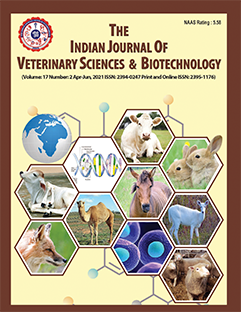Microbiological Quality of Community and Animal Drinking Water in and around Mhow, Indore, Madhya Pradesh
DOI:
https://doi.org/10.48165/ijvsbt.21.5.29Keywords:
Drinking water, E. coli, Indicator, Microbiological quality, Most probable number (MPN)Abstract
Microbial contamination of drinking water is a significant public health issue, particularly in developing regions where sufficient sanitation, hygiene, and water treatment are often lacking. This study aimed to assess the microbiological quality of drinking water from various sources with a focus on the presence of Escherichia coli as an indicator of fecal contamination. A total of 240 samples collected in and around Mhow, Indore (MP) (80 each community drinking, packaged water and animal drinking water), were analysed for microbiological quality by multiple tube technique, which displayed MPN (most probable number) indices from <3 to >1100 MPN/100 mL. Based on MPN count, water samples available for human drinking (both community and packaged water combined) were graded as satisfactory (63.75%), suspicious (6.25%) and unsatisfactory (30 %). However, only 0.98% samples graded satisfactory were positive for E. coli. Conversely, 30 % and 35.41% samples observed suspicious and unsatisfactory, respectively, showed the presence of E. coli. In source wise investigation of human drinking water samples, 27.50%, 12.50% and 60.00% community drinking water samples were observed as satisfactory, suspicious and unsatisfactory, respectively, wherein E. coli was detected in 4.54%, 30.00% and 35.41% samples, respectively. On the other hand, all the packaged water samples (100%) were found satisfactory for drinking without presence of E. coli in any of the sample. In the animal drinking water samples, presence of coliforms (100%) including E. coli (31.25 %) found was of considerable concern. High percentage of unsatisfactory water samples with presence of E. coli indicate likely sewage contamination and highlights the urgent need for immediate attention, and action to reduce the risk of water-borne diseases.
Downloads
References
Abera, S., Zeyinudin, A., Kebede, B., Deribew, A., Ali, S., & Zemene, E. (2011). Bacteriological analysis of drinking water sources. African Journal of Microbiology Research, 5(18), 2638-2641.
Ahmed, T., Baidya, S., Acharjee, M., & Rahman, T. (2013). Qualitative analysis of drinking water through the most probable number (MPN) method. Stamford Journal of Microbiology, 3(1), 9-16.
Bano, S., Malik, S.A., & Sidhu. (2022). Bacteriological analysis of drinking water from water coolers. International Research Journal of Modernization in Engineering Technology and Science, 4(1), 71-75.
BIS. (2012). Specification for drinking water IS: 10500:19. Bureau of Indian Standards, New Delhi.
FDA - Food and Drug Administration. (2023). Enumeration of Escherichia coli and the coliform bacteria. Chapter 4, In: Bacteriological Analytical Manual. Retrieved from https://www.fda.gov/food/laboratory-methods-food/bam-chapter-4-enumeration-escherichia-coli-and-coliform-bacteria
Goel, S., Sood, R., Mazta, S.R., Bansal, P., & Gupta, A. (2007). Bacteriological quality of water samples of a tertiary care medical center campus in north western Himalayan region of India. Internet Journal of Third World Medicine, 5(1), 1-7.
Jayana, B.L., Prasai, T., Singh, A., & Yami, K.D. (2009). Assessment of drinking water quality of Madhyapur-Thimi and study of antibiotic sensitivity against bacterial isolates. Nepal Journal of Science and Technology, 10, 167-172.
Kumar, D., Malik, S., Madan, M., Pandey, A., & Asthana, A.K. (2013). Bacteriological analysis of drinking water by MPN method in a tertiary care hospital and adjoining area Western UP, India. Journal of Environmental Science, 4(3), 17-22.
Mahajan, R., Suharshi, K., & Mahajan, B. (2018). Bacteriological analysis of drinking water samples from various sources in Jammu. International Journal of Current Microbiology and Applied Sciences, 7(7), 2795-2799.
Mahbub, .R., Nahar, A., Ahmed, M.M., & Chakraborty, A. (2011). Quality analysis of Dhaka WASA drinking water: Detection and biochemical characterization of the isolates. Journal of Environmental Science and Natural Resources, 4(2), 41-49.
Malathy, B.R., Sajeev, S.K., Thampy, S., & Guruvayurappan, K. (2017). Bacteriological analysis of drinking water by MPN method from Chennai, India. Journal of Environment Science, Toxicology and Food Technology, 11, 57-64.
Munster, P., & Kemper, N. (2024). Long-term analysis of drinking water quality in poultry and pig farms in Northwest Germany. Frontiers in Animal Science, 5, 1467287.
Nyakundi, V., Munala, G., Makworo, M., Shikuku, J., Ali, M., & Song’oro, E. (2020). Assessment of drinking water quality in Umoja Innercore Estate, Nairobi. Journal of Water Resource and Protection, 12, 36-49.
Phyo, S.S.M., Yu, S.S., & Saing, K.M. (2019). Bacteriological examination of bottled drinking water by MPN method. Haya: The Saudi Journal of Life Sciences, 4(7), 227-232.
Rizwan, N., Banday, T., Abdullah, M., Shiekh, I.U., Akand, A., Pampori, Z., & Ali, H. (2023). Evaluation of drinking water quality for animals at MRCS&G farm, SKUAST-K. The Pharma Innovation Journal, 12(5), 935-939.
Roy, C., Joshi, A., & Katiyar, V. (2013). Bacteriological analysis of drinking water. In National Symposium on Biotechnology: Present status and future prospects, 15 March, Department of Biotechnology, DCRUST, Murthal, Haryana, India, pp. 1-12.
Satish, K.S., Gupta, B., Singh, R.V., Rani, B., & Birla, S. (2018). Determination of physical and bacteriological quality of water based on most probable number (MPN) count, pH and total hardness of water sources in and around Jabalpur city of Madhya Pradesh, India. International Journal of Current Microbiology and Applied Sciences, 7(7), 2970-2978.
Soares, A.S., Miranda, C., Coelho, A.C., & Trindade, H. (2023). Occurrence of coliforms and Enterococcus species in drinking water samples obtained from selected dairy cattle farms in Portugal. Agriculture, 13(4), 885.
Tharannum, S., Sunitha, S., Nithya, J., Chandini, M., Manitha, J., Manjula, T.S., & Sundar, C.S. (2009). Molecular confirmation of the presence of coliforms in drinking water using polymerase chain reaction. Kathmandu University Journal of Science, Engineering and Technology, 5(2), 130-136.
Downloads
Published
Issue
Section
License
Copyright (c) 2025 Indian Journal of Veterinary Sciences and Biotechnology

This work is licensed under a Creative Commons Attribution-NonCommercial-NoDerivatives 4.0 International License.




